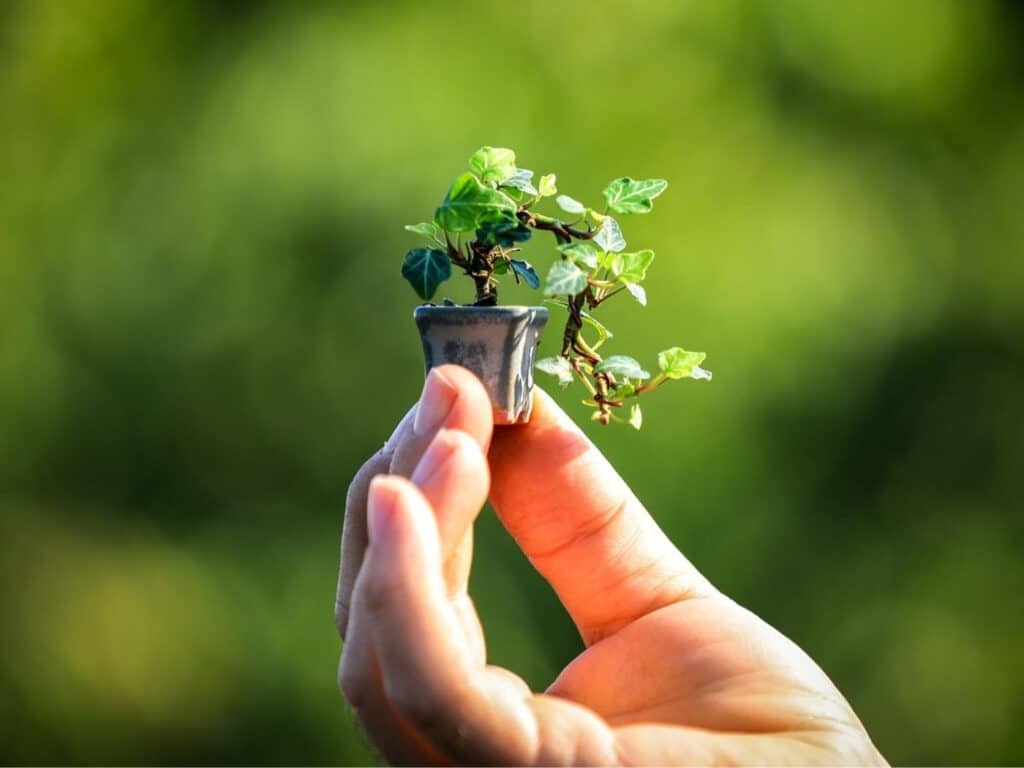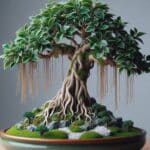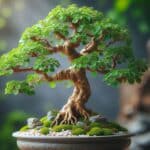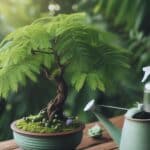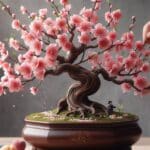Bonsai trees are known and beloved for their miniaturized appearance. These trees are carefully grown, maintained, and pruned to create a small tree with a mature and aged appearance. Bonsai enthusiasts use all sorts of techniques to create interesting and attractive trees.
The small trees come in many different sizes. They range from as tiny as just 1 inch to 16 feet tall and are all potted in minuscule or flattened containers. Because these trees vary in size, they fall under categories such as small, medium, and large bonsai trees.
Mini bonsai trees are some of the most popular because a tree with a 4 – 8 inch height is easiest to maintain and care for since you can easily handle, transport, or move it, yet big enough to offer lots of interest inside a room or outdoor space.
If you want to grow a beautiful mini bonsai tree, then it is best to start with the right species. In this guide, we will look at some of the best varieties for growing mini bonsai.

Size Classification for Miniature Bonsai Trees
Bonsai trees are classified into three main categories: miniature, medium, and large. These main categories also have subcategories under which trees can fall. The biggest differentiation factor for these different tree categories is usually the tree’s size and the container’s size.
For mini bonsai tree categories, there are five main or most common subcategories, which include the following:
Kenshitsubo
Kenshitsubo bonsai trees are also known as poppy seed-sized bonsai trees and are the smallest possible bonsai size. These trees usually range from 1 – 3 inches tall and can easily be lifted with just two fingers.
Shito
Shito bonsai is also a very small bonsai size, but it is more common than Kenshitsubo trees. These trees are also called thimble bonsai because they are usually planted in pots no bigger than a thimble. The trees are usually fingertip size with a height of 2 – 4 inches.
Shohin
Shohin trees overlap a little bit because some are considered shito bonsai while others are considered mame bonsai. However, the techniques used for growing shohin trees differ a little bit from those used for shito trees. These trees are often referred to as palm bonsai because they can fit in the palm of your hand. These trees are usually 2 – 6 inches tall.
Mame
Mame bonsai are often called one-handed trees because you only need a single hand to move them around. These trees are usually 4 – 8 inches tall and have larger pots than shohin trees. They are more common than Shohin bonsai trees because maintaining this slightly larger size is a bit easier.
Komono
Komono trees are usually 6 – 10 inches tall and are the biggest mini tree that can be moved with a single hand.
What is the Smallest Type of Bonsai Tree
Kenshitsubo bonsai trees are the smallest classified size of bonsai trees. These trees usually range from 1 – 3 inches tall and are usually fitted into tiny pots to maintain their miniature size. These tiny trees are usually grown from seed and are then specially crafted to maintain their petite size.
Best Tree Species for Growing a Mini Bonsai Tree
It usually takes about 3 – 5 years to grow a mini or mame bonsai tree. These trees usually range from 4 to 8 inches tall and are often grown from cuttings or seed. Many plants can be used to grow mame bonsai, but the following are some of the most popular species.
Crabapple Bonsai Tree

The crabapple bonsai tree (Malus) or crab apple bonsai tree is one of the most popular species for growing mame bonsai. This is because this tree variety is pretty easy to care for, and you can shape and style it into any bonsai shape. This plant species is ideal for bonsai beginners and advanced bonsai hobbyists.
Crabapple trees produce attractive bonsai trees because they produce colorful fruit that ranges from yellow to red. They also produce blooms in colors like white, red, or purple; their leaves vary in shape and form depending on the species.
These trees are unsuitable for indoor growth and should be placed outside in a full-sun position. They prefer moist soil but can be in a partial shade location if you want to water them more infrequently.
These trees are not cold tolerant and should be shielded during the chilly winter months or kept indoors when it is cold out.
Chinese Elm Bonsai Tree
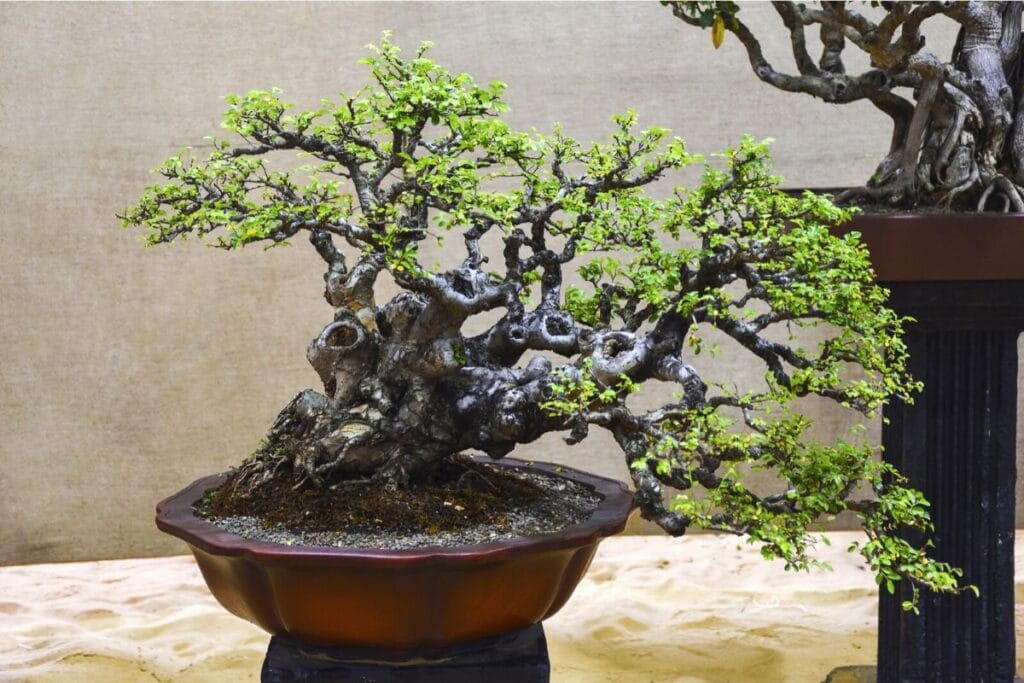
Chinese elms (Ulmus parvifolia) are popular for bonsai trees because they can be kept indoors or as semi-outdoor bonsai. They can grow in full sun or partial shade and are often positioned outdoors during winter and indoors during summer. These cold-hardy trees produce delicate foliage that is perfect for creating mini trees with an aged appearance.
Chinese elms do grow quite quickly. If you are using this plant species for mini or mame bonsai creations then you should repot them every year or two and keep the root system and tree pruned.
This plant is ideal for creating interesting bonsai because it has a noticeably thick trunk and saplings can be trained to grow in a wide range of interesting bonsai shapes.
Satsuki Azalea Bonsai Tree

Satsuki Azalea (Rhodondendron indicium ‘Satsuki azalea’) is a favorite plant species for floral bonsai trees. There are quite a few varieties of this flowering miniature plant, and they come in many flower colors.
The Japanese cultivated this plant, which is a very popular choice for bonsai since it is hardy, easy to grow, and attractive in full bloom. The shrub is also evergreen and will offer year-round interest.
To keep these trees small, their watering schedule is kept quite strict. The trees are saturated or soaked once, followed by shallow watering every other cycle. These trees are also kept in a small container with regular pruning to maintain their small size.
Ficus Bonsai Tree
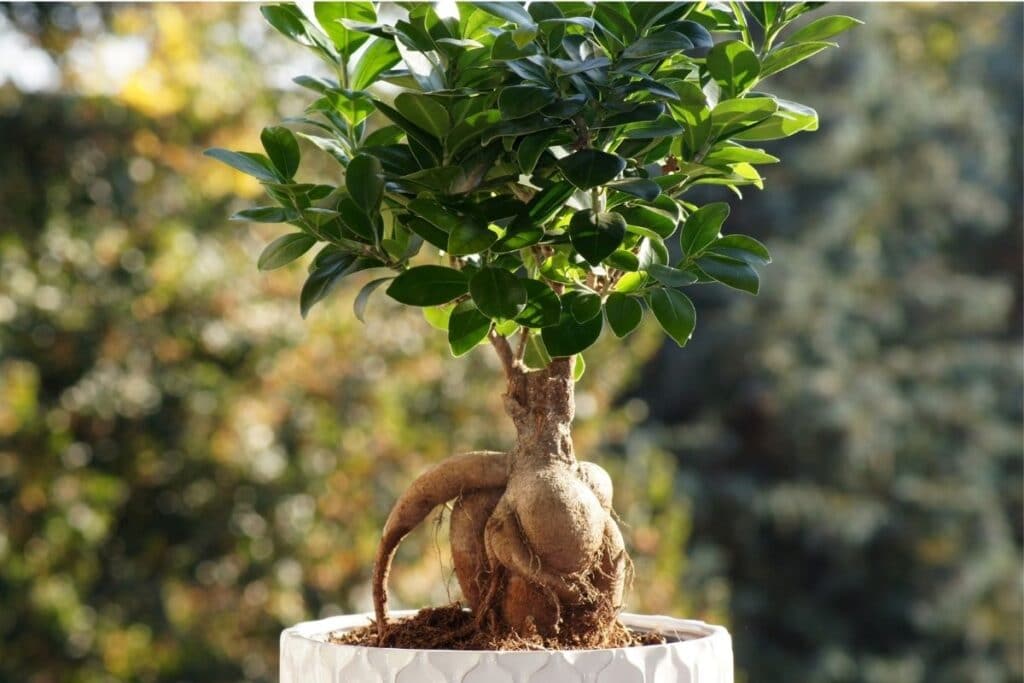
The ficus plant (Ficus) is one of the most popular tree species for growing bonsai. The Retusa and Ginseng varieties are especially popular for smaller or mini bonsai trees.
This plant species is a typical pick for bonsai because it can be kept indoors, is reasonably easy to propagate, and can be very hardy. The saplings are easy to manipulate to form a desirable shape, and these trees grow quite rapidly, which is ideal for giving your tree a mature appearance in less time.
These evergreen trees look attractive throughout the year and have a pretty good repotting survival rate thanks to their hardy nature.
Maple Tree

Maple trees (Acer) are also commonly used for bonsai trees and are quite popular as mame bonsai because they can be kept quite small.
These deciduous trees can add lots of color to your spaces because their leaves will transform into red and orange colors during fall. The delicate branches of this tree can also look attractive even when all of the leaves have fallen off.
Acer trees do grow rapidly and should be kept in small containers and regularly repotted to maintain a small size. They don’t grow well indoors but will flourish in an outdoor position.
How to Grow a Mini Bonsai Tree
When you are growing a mini bonsai tree, it is always best to start with a sampling or to grow it from seed. you can also propagate these trees by growing 5-inch long cuttings.
Here is a quick look at the steps for growing your own mini bonsai tree.
Step 1 – Propagation
First, you will need to propagate some cuttings or grow some plants from seed. The growing method for cuttings and seedlings may vary for different plant species. It is usually best to research your tree species and to find out what the best propagation method for that plant might be.
Step 2 – Repotting
Once your tiny plant starts to grow healthy, it is time to repot it in some fresh soil. Use a small container so the little tree won’t produce a vigorous root system. It is also best to plant your tree in a bonsai potting mixture.
While you are repotting the small tree, you should take the time to trim the lead branch to encourage some branching. You should also remove any unwanted branches.
Step 3 – Shaping and Wiring
Once re-potted, you can take some aluminum or copper wire to wire the trunk and branches of the tree. It is usually best to do wiring in winter before the new growth appears. Before wiring, you should cover the branch with some raffia paper. This will help avoid trunk damage. After wiring, you can shape your tree into a desirable form and trim away any unwanted branches and growth.
Step 4 – Prune and Maintain
Keep pruning and pinching back the tree to stunt its growth. The tree should also be repotted every one to two years and excess roots should be trimmed back.
After about 3 – 5 years of constant care, you should have a pretty decent-looking miniature bonsai tree.
Final Thoughts
Crabapples, chinese elms, Satsuki rhododendrons, ficus trees, and maple trees are some of the best varieties to transform into mini bonsais. You can, however, also successfully grow other varieties like pinus, Picea, Juniperus, salix, and tamariz into tiny trees that are pleasant to look at and easy to care for.
We hope that you enjoyed our guide and that you will now have a much better idea of the right plant species to use for creating interesting minuscule trees that can easily fit on your desk.
Up next:

